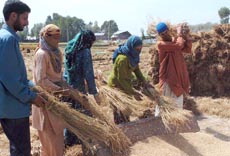|
 |
|
Kashmiri farmers reap the harvest
after a year's toil.
(Photo:
Zulfiqar Khan/IANS) |
Srinagar:
As grain-laden stalks of golden yellow impart a magical hue to the
paddy fields of the Kashmir Valley, for local farmers, the season
of plenty is here at last. And they have to get the work done
quickly, come rain, storm or labour shortage.
There is a nip in the morning and evening air, but harvesting
their year's labour is top priority for thousands of families
engaged in paddy cultivation.
"Labour is hard to come by these days, one has to depend mostly on
one's family to reap, thresh and shift the paddy this year," said
Muhammad Rajab, 52, a farmer in north Kashmir Ganderbal district.
The unemployed in the rural areas of Ganderbal district and
elsewhere in the state are engaged in various programmes being
executed these days under the Mahatma Gandhi National Rural
Employment Guarantee Act (NREGA).
"I get Rs.140 per day and the flood protection work being carried
out in the village is close to my home. This year I have not been
troubled to look for work outside the villages because of NREGA,"
Sultan Dar, 34, a villager in Ganderbal district, told IANS.
Weather is one of the most critical and limiting factors and
dictates haste to the farmers once the paddy turns ripe.
"When the grains are mature and heavy, they droop and the stalks
bearing them start giving way. Harvesting must take place quickly
so that the grains do not fall down," said Nazir Ahmad Mir, 42, a
farmer in Benhama village of Ganderbal district.
"Also, a light rain or god forbid, a hailstorm, can rid the paddy
plants of their grains. Thus, harvesting, gathering and threshing
has to happen in quick succession."
The majority of the valley's paddy is produced in the south
Kashmir districts of Anantnag, Pulwama, Kulgam and Shopian and for
this reason, south Kashmir has been called the rice bowl of the
valley.
"But no longer. Most of the agricultural land in the valley has
been converted into residential plots and sold at exorbitant
prices as paddy cultivation has never been a profitable vocation
here," said Bashir Ahmad War, a retired veterinarian here.
"The agricultural lands are protected under local laws and the 'A'
grade agricultural lands have been reserved exclusively for paddy
cultivation. No construction, conversion is allowed under the
state laws on these lands, but unscrupulous revenue officials
tamper with the records and facilitate the sales of these
agricultural lands."
Even though pollution has been weighing heavily on the local
environment, including lakes, rivers, forests, wetlands, most of
the mountain streams and rivers fortunately still run crystal
clear, murmuring as they tumble over stones and sand.
"There is no music like the music of a brook. It is more soothing
than Mozart. We are callous, self-destructive and ignorant. One
day even what is left of the mountains, forests and wetlands will
be lost. Nobody seems to bother. What is our concern for
posterity?" professor Muzaffar Ahmad, a local college principal,
told IANS.
Despite the colossal damage suffered by local forests, lakes,
rivers and wetlands, Kashmir is still the most beautiful place one
can ever visit.
And for farmers, the first priority continues to be the timely
harvesting of their produce.
"Time and tide wait for none, a light rain or an autumnal
hailstorm can undo the whole year's toil," said Hassan Parray,
another farmer in Haripora village on the Srinagar-Leh national
highway.
(Sheikh Qayoom
can be contacted at sheikh.abdul@ians.in)
|



















